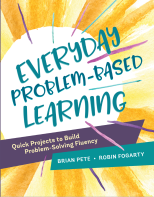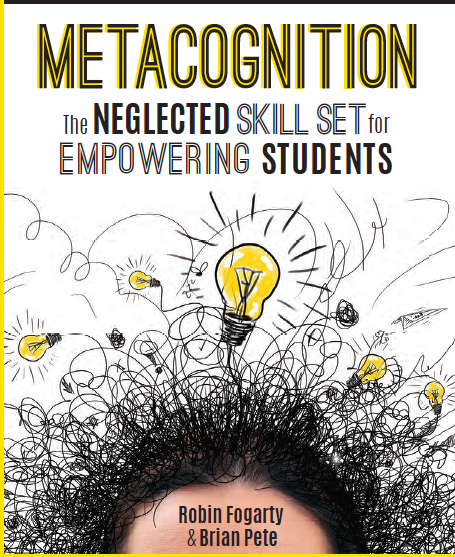PBL-Problem-Based Learning is more than just projects. PBL experiences are standards-based, with rigorous thinking skills, and rich literacy skills threaded through the models allowing student learning to reaches far beyond the classroom experience and into real world applications.
Grounded in the work of David Perkins at Harvard’s Project Zero, the concepts of Making Learning Whole(Perkin’s, 2014), each PBL experience presents a complete PBL cycle, just as problem solving in life runs the course from questioning, analyzing, synthesizing, generating alternatives and selecting the best option. In addition, true PBL work involves that good ole, highly touted, trait called American ingenuity. At the same time, PBL life lessons tap into that very nature of the enterprising entrepreneur, again often attributed, rightly or wrongly to Americans.
The centerpiece of inquiry learning includes a mosaic of adventures: exploration, investigation, experimentation, and evidence-based learning. Yet, when coupled with talent, ignited by motivation, skillful with deliberate practices and guided with master coaching, the process (Colye, 2009) lays the groundwork for building necessary expertise as self-initiating, self-directed and self-assessing young leaders. In brief, PBL naturally, manifests itself in authentic, real world learnings that serve our youngsters well as they prepare, not just for “the” test, but rather for a far richer set of outcomes. Students grappling with genuine PBL inquiries are, in essence, preparing for the test of life.
Google Hires
According to Google Hires, (Friedman, 2014), there is an evolving set of intangibles that are rising in the profiles of “most desired employees”. And these are the very same values that drive student learning in PBL classrooms. Included in this listing, are skills that resemble the former skills of authentic leadership, peer collaboration, productive problem-solving and sound decision-making, yet the tone and tenor of these “Google Hire” skills take on a subtle, but substantive collage of behavioral capabilities.
Along with enormous office spaces, often in renovated industrial spaces, seldom separated by high or low dividers, featuring ping pong tables, pool tables, kitchen facilities and wrap around couches, the emergent 21stCentury work space is not the only dramatic changes on the scene. The qualities of top candidates have been remodeled too. Among the attributes that stand out are five behaviors that seem to define the kind of young people selected for the team.
To best describe these five desired dispositions, character traits or habits of mind, the concepts of spontaneouslystepping up,or stepping in, stepping in the middle of, or stepping asideor even, stepping it upare subsets of desired behaviors evidenced as the new qualifiers for the top candidates for the millennial workplaces today.
Step Up to the Plate (Emergent Leadership)
Rather than simply seeking the perennial class President, the emergent leader, the surprising rising star, that top firms are noticing, are the kids in PBL scenarios, who step upto the plate when there is an obvious need for someone to take charge. They intuitively know when a leader is needed to keep things moving along. They may be the ones who get the necessary supplies, or ask permission for the group to move locations beyond the eyes and ears of the authority figure, as they proceed with their plan. They are risk-takers, problem-solvers and congenial human beings who have that knack or charisma to push the envelope and take the lead.
Step In and Do What Needs to Be Done (General Cognitive Ability)
It’s no longer the brightest student or highest achiever coveted for the top jobs, but rather the pragmatic peer who can synthesize disparate bits of information and make perfect sense of it in the heat of the action. These individuals spontaneously step inwhen they have a sense of the solution or the key to puzzling circumstances. They are in it, lock, stock and barrel and will go to great ends to make things happen in order to reach that end goal. These are the “doers” who take full and responsibility of the situation and the team can be sure that the one that magnanimously steps in, will not stop until it is done. These team members are selfless and really have the greater good of the group in mind.
Step Into the Middle as an Early Adapter (Sense of Ownership)
Conventional wisdom honors the ones who take full ownership of the problem at hand. In fact, this is one of the traits teachers often look for as students take on more and more responsibility in the PBL classroom inquiries. This is the person who is an early adaptor, jumps in full on from the beginning, and owns the problem. This person exhibits this personal investment and a sense of obligation to see the thing through to fruition. This kind of commitment can be learned. In fact this is a monumental skill developed with ongoing PBL scenarios. Students genuinely adopt the viewpoint of their stakeholder role, and there is no end to the effort, ingenuity and creative problem solving they will do to represent that particular point of view. Owning the problem is how students wrap themselves in true responsibility and do whatever it takes to make things happen in the most beneficial ways possible from their accepted perspective.
Step Aside and Honor the Talents of Others (Intellectual Humility)
The one who can step aside, who has the intellectual humility to realize he does not have all or the only answer to a problem, is a rare breed. Even the kids in the early grades have total tunnel vision when they contribute a word to the Word Wall. They want to see THEIR word and they don’t especially care about anyone else’s word. Yet, in PBL situations, the ability to honor others’ opinions and ideas, to see that each member as a valued, contributing member. These members understand that the mix of talents and abilities serve the means to an end. Projects often will exceed all expectations for creative innovation-fluency, flexibility, elaboration and uniqueness as each member of the team contributes her talents to that final effort.
Step It Up with a Natural Curiosity to want to Know (Innately Curious)
Curiosity is the natural born gift of our youngest members of society. They wonder why, ask about how, think about when and what and where. Their questions are endless, and deep, with complexity inherent in the real and full answer. But that is not what they need at that point in time. Yet, if we must somehow learn to foster, to cultivate to tend to the curious notions that pepper the day, if we are to instill that curiosity as a positive and desired trait to develop and grow. Those who possess no curiosity or have somehow learned to bury it deep inside their quest for good grades and compliance, are missing the “oomph” that generates ingenious enterprises from these original thinkers; these “screenage” developers of the latest and greatest apps; the inventors, writers, comedians and technicians with their constant flow of surprises that cause chaos and comedic moments, as well as groundbreaking applications that change our world daily. Curiosity is not the bother we sometimes relegate it as, but definitely, a highly desired trait. We must find ways to appreciate, coach and foster that trait; keep it well, alive and thriving. It’s our future and PBL plays a huge role in preserving this wonderful element of the intellect.
Stepping into the future requires these remarkable young minds, that standout not for their ability to conform and comply, but for their abilities to stand out and be different; to know they have something worthwhile to offer in a world of unknown challenges.
Resources
Byant, A. (June 19, 2013) Corner Office: Laszlo Bock In Head-Hunting, Big Data May Not Be Such a Big Deal. New York Times
Coyle, D. (2009).The Talent Code: Greatness is Born. It’s Grown. Here’s How. New York: Bantom Dell: A Division of Books Random House
Friedman, T. (February. 22, 2014). How to Get a Job at Google Hint: Getting hired is not about your G.P.A. It’s about what you can do and what you know.
Perkins, D. (2009) Teaching for Wholeness




